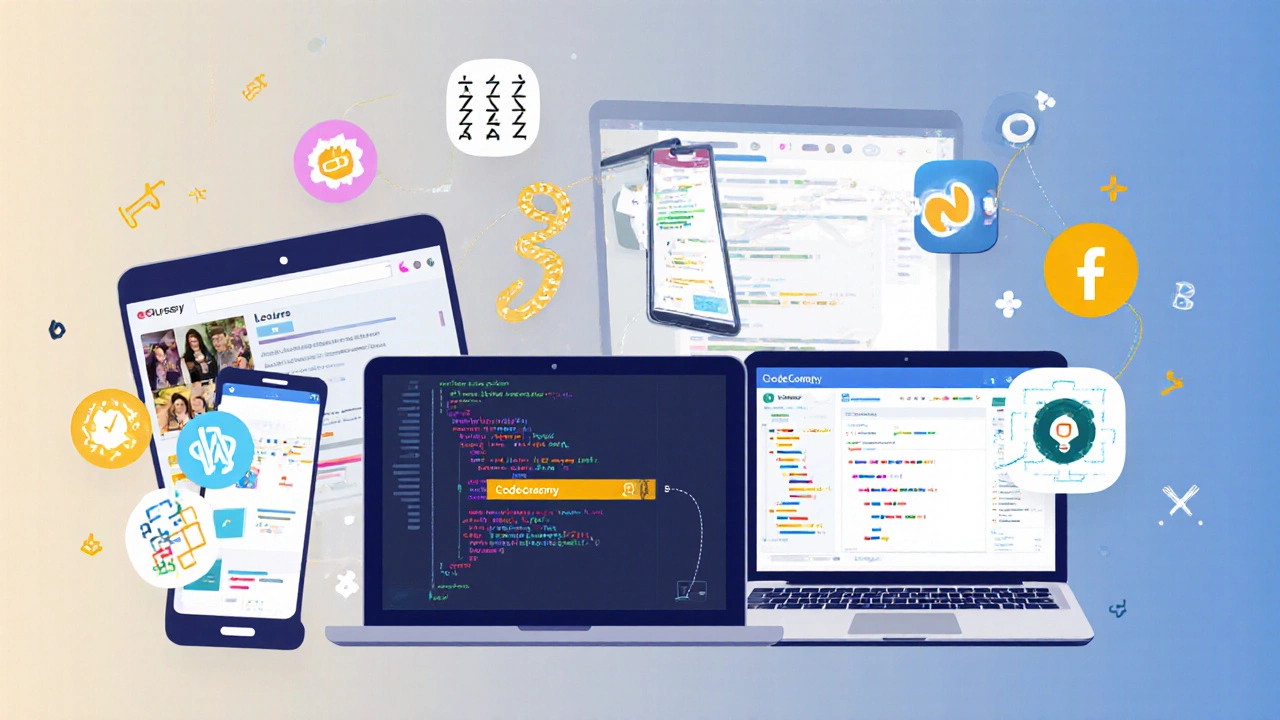Coding Class Finder
Find Your Perfect Coding Class
Answer these quick questions to get personalized recommendations based on your goals, budget, and learning style.
Your Recommended Classes
Why these recommendations?
Based on your goal to , budget of , and learning style, we recommend classes that match your criteria and offer the best value for your situation.
Coding classes are structured learning experiences that teach you how to write computer programs, solve problems with code, and build real‑world applications. Whether you prefer video lessons, interactive labs, or in‑person workshops, the right class can accelerate your journey from zero to hero.
How to Pick the Right Coding Class
Before you sign up, ask yourself three questions:
- Goal: Do you want a hobby, a new job, or a promotion?
- Style: Self‑paced videos, live instructor sessions, or project‑based labs?
- Budget: Free community resources, subscription platforms, or premium bootcamps?
These criteria map directly to four evaluation factors that most learners use:
- Curriculum depth: Does the syllabus cover fundamentals (variables, loops, conditionals) and advanced topics (APIs, data structures) that match your goal?
- Instructor credibility: Look for instructors with industry experience or academic credentials. For example, Udemy hosts courses taught by senior developers from Google, Amazon, and startups.
- Hands‑on practice: Coding is a skill you build by doing. Classes that include real projects, code reviews, and peer feedback produce better outcomes.
- Support ecosystem: Forums, mentorship, and job‑placement services can make a huge difference, especially for career‑switchers.
Top Categories of Coding Classes
Based on the evaluation factors, most learners fall into one of these five buckets:
- Massive Open Online Courses (MOOCs): Platforms like Coursera partners with universities such as Stanford and the University of London and edX offers professional certificates from MIT and Harvard. They blend lecture videos with graded assignments.
- Interactive Learning Sites: Sites such as Codecademy focuses on browser‑based coding exercises in languages like Python and JavaScript or freeCodeCamp provides a free, project‑driven curriculum that leads to a full‑stack developer certification.
- Paid Course Marketplaces: Udemy offers a la carte courses ranging from $10 to $200, often on sale and Khan Academy covers fundamentals for free with a strong emphasis on computer science theory.
- Immersive Bootcamps: Programs like General Assembly run full‑time, 12‑week intensive courses that guarantee a portfolio and job‑search support. They are pricey ($10,000‑$15,000) but include mentorship and hiring partnerships.
- Community & School Programs: Local libraries, community colleges, and after‑school clubs (e.g., Google's CS First offers free coding clubs for K‑12 students) provide low‑cost or free access to basic programming concepts.
Feature Comparison of Popular Platforms
| Provider | Pricing (USD) | Typical Length | Top Languages | Career Support |
|---|---|---|---|---|
| Coursera | $39‑$79 per month (subscription) | 4‑12 weeks per specialization | Python, Java, SQL | Resume review, LinkedIn badge |
| Udemy | $10‑$200 one‑time per course | Self‑paced (typically 10‑30 hrs) | Python, JavaScript, C# | None (student‑led) |
| Codecademy | $40 per month (Pro) | Self‑paced, modular tracks | HTML/CSS, JavaScript, Python | Portfolio projects, interview prep |
| freeCodeCamp | Free | Self‑paced, ~3000 hrs for full certification | JavaScript, Node.js, React | Community job board, open‑source contributions |
| General Assembly | $12,950 (full‑time) | 12 weeks intensive | Full‑stack JavaScript, UX design | Dedicated career coach, hiring partners |

Best Coding Classes for Specific Goals
Beginner who just wants to “play” with code
- freeCodeCamp - zero cost, project‑driven, perfect for learning HTML, CSS, and JavaScript at a casual pace.
- Khan Academy - short videos plus interactive challenges that introduce programming logic.
Career‑switcher aiming for a junior developer role
- General Assembly - immersive, with a built‑in portfolio and interview prep.
- Coursera’s Google IT Automation with Python - 6‑month professional certificate, recognized by recruiters.
Advanced developer looking to specialize
- edX MicroMasters in Data Science - deep dive into Python, R, machine learning, and big‑data tools.
- Udemy’s “Advanced React and Redux” - project‑focused, suited for front‑end engineers.
Kids and teens
- Google’s CS First - free, video‑based, classroom‑ready modules that teach Python through games.
- Scratch (by MIT Media Lab) - drag‑and‑drop environment that builds computational thinking without typing code.
Tips to Get the Most Out of Any Coding Class
- Set a weekly coding schedule. Consistency beats intensity; aim for 4‑6 hours a week.
- Apply concepts immediately. After each lesson, build a tiny project - a to‑do list, a weather widget, or a simple game.
- Leverage community forums. Sites like Stack Overflow, the provider’s Discord, or Reddit’s r/learnprogramming are gold mines for troubleshooting.
- Document your code. Write a short readme for every project; it reinforces learning and looks good on a résumé.
- Seek feedback. Pair‑program with a peer or ask an instructor to review your pull request.

Common Pitfalls and How to Avoid Them
Many learners drop out because they hit a wall. Here are three usual traps:
- Choosing a class that’s too advanced. If a course expects you to know object‑oriented programming but you’re still learning loops, you’ll feel lost. Start with a “beginner” label and follow the progression.
- Skipping the hands‑on part. Watching videos without coding yields low retention. Treat every lesson as a lab.
- Neglecting the portfolio. Employers want to see code, not certificates. Keep a GitHub repo updated with at least three polished projects.
Quick Checklist Before You Enroll
- Does the syllabus match my goal?
- Are there real‑world projects?
- Is there a clear support channel?
- Can I afford the price or is there a free trial?
- Do alumni report job placement or skill gains?
Frequently Asked Questions
Are free coding classes as good as paid ones?
Free classes can be high quality-freeCodeCamp and CS First produce thousands of graduates each year. The key difference is usually support: paid bootcamps often include mentorship and job‑placement services, while free platforms rely on community forums.
How long does it take to become employable?
It varies. Immersive bootcamps aim for a job within 3‑4 months of full‑time study. Self‑paced MOOCs or marketplace courses can take 6‑12 months, depending on how many hours you dedicate each week.
Do I need a degree to enroll in a coding class?
No. Most platforms only require curiosity and basic math. Some bootcamps ask for a short interview to gauge commitment, but degrees are rarely a prerequisite.
Which programming language should I start with?
Python is the most beginner‑friendly: simple syntax, strong community, and applicability in web, data, and automation. If you’re eyeing front‑end web work, start with HTML/CSS then JavaScript.
Can I switch from one class to another midway?
Yes, most online platforms allow you to pause and start a new course. Just make sure you finish any certifications you need for your résumé.
Finding the perfect coding classes boils down to matching your goals, learning style, and budget with the right curriculum and support. Use the criteria, comparison table, and checklist above, then start coding-your future self will thank you.
